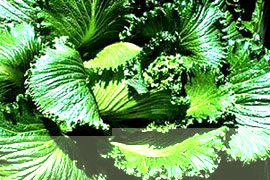


Home
Flowers &
Indoor Plants
Fruits & Nuts
Ornamentals
Vegetables
Special Topics
Resources
Glossary

|
Chinese Cabbage Brassica rapa (brass-ih-cah ra-pah) 
Click on thumbnails for larger image. |
 |
What about it? Chinese cabbage, a sweet, crunchy vegetable, is best grown as a fall crop. There are two basic types: heading and non-heading. Heading varieties can be short and round, or tall and torpedo-like. The nonheading type forms loose, upright leaves. What is it used for?Chinese cabbage is an edible green rich in vitamins A, C, and K. Where does it grow? How do we grow it? Cabbage plants thrive in heavy soils that hold moisture, but they will develop problems in overly wet soils. They do best during a cool season. One of the benefits of growing Chinese cabbage is that is doesn't need very much room to provide plenty of greens. Ten feet would be adequate for a season's planting. Sow Chinese cabbage seeds in the fall, 1/4 to 1/2 inch deep and 3 inches apart. When the seedlings are 4 to 5 inches tall, thin them to 12 to 15 inches apart. What are its primary problems? Chinese cabbage is susceptible to the same insects and diseases as the other cabbage members of the cabbage group: aphids, cabbageworms, cabbage loopers, blackrot, clubroot, downy mildew, and mosaic. Flea beetles find Chinese cabbage especially tasty. How do we harvest and store it? You can begin harvesting heading types when the leaves are 10 inches tall and still loose, or you can wait until the heads are fully formed. Cut heads at soil level. Begin harvesting nonheading types when there's enough to eat. Cut off a few outside stalks at a time or harvest the entire plant. To store as long as possible, harvest Chinese cabbages late in the season before the first hard frost. If kept in a cold, moist area, the heads can last for 3 to 4 months. The higher the temperature, the shorter the storage period. In a dry, cold area wrap heads in waxed paper to create humidity. Store only solid, blemish-free heads.
© Copyright, Department of Horticulture, Cornell University. |